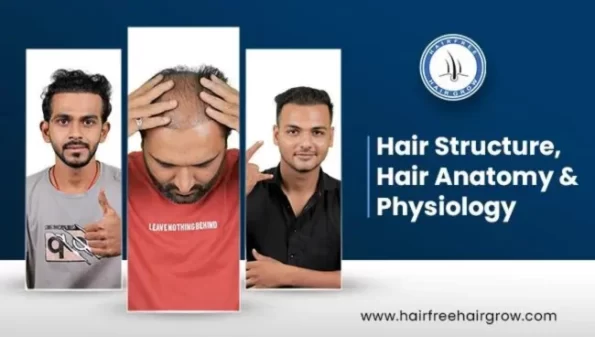Hair Structure, Hair Anatomy and Physiology – these are the building blocks that make up the most visible part of our body. Have you ever wondered how your hair grows, why it looks a certain way, and what role it plays in your overall health? In this article, we will delve into the fascinating world of hair and explore its intricate structure and the biology that underlies its growth.
Understanding hair structure, anatomy, and physiology is essential to maintaining healthy hair. Our hair comprises three layers – the medulla, cortex, and cuticle – each with unique properties and functions. The medulla is the innermost layer, followed by the cortex, which gives hair its strength and elasticity, and the cuticle, which acts as a protective shield. We will explore each of these layers and how they contribute to the overall structure of our hair.
So, what are the factors that affect hair growth and its health? Several factors can impact hair growth, texture, and appearance from genetics to nutrition, hormones to lifestyle choices. We will examine the physiology of hair growth, the stages of hair growth, and how various internal and external factors can influence hair health.
Whether you’re looking to improve the appearance of your hair or understand the science behind it, this article is for you. With insights from leading experts in the field, we will explore the latest research on hair structure, anatomy, and physiology to comprehensively understand one of the fascinating parts of the human body. So, let’s get started!
The Anatomy of Hair: Understanding Hair Growth
As a vital part of our appearance, hair is an aspect of our body that we often want to keep healthy and presentable. To achieve this, we must first understand the anatomy of hair and how it grows.
Hair Follicles: The Foundation of Hair Growth
At the base of each strand of hair lies a follicle. This small, sac-like structure is located within the dermis and is responsible for producing new hair. The follicle is surrounded by sebaceous glands, which secrete oil to lubricate the hair and skin. Additionally, the arrector pili muscle, which is responsible for making the hair stand up when we experience emotions such as fear or excitement, is attached to each hair follicle.
The structure of hair can be divided into three main layers – cuticle, cortex and medulla. Each layer plays an important role in determining the health, strength and texture of the hair.
Cuticle Layer
The cuticle layer is the hair shaft’s outermost layer and protects the hair from damage. It is made up of many layers of overlapping scales, resembling tiles on a roof. The cuticle layer helps seal in moisture and provides a barrier against environmental factors such as heat, UV radiation, and chemical damage. When the cuticle layer is damaged or compromised, hair becomes more susceptible to breakage, split ends, and other types of damage.
Cortex Layer
The cortex layer is the middle layer of the hair shaft and is responsible for providing strength and elasticity to the hair. It contains a fibrous protein called keratin, which gives hair its character and elasticity. The cortex layer also contains pigments that give the hair its color and help determine the texture and curl pattern of the hair. When the cortex layer is damaged, hair can become weak, brittle, and prone to breakage.
Medulla Level
The medulla layer is the innermost layer of the hair shaft and is present only in certain types of hair. It is a soft, spongy core made up of loosely packed cells. The function of the medulla layer is still not fully understood, but it is believed to play a role in the overall structure and thickness of the hair.
Understanding the Hair Growth Cycle
Hair growth is a cyclical process that can be divided into three main phases: the anagen phase, the catagen phase, and the telogen phase.
Anagen Stage
Anagen is the hair cycle’s active growth phase, typically lasting 2-8 years. During this phase, the hair follicle enlarges and takes its original shape, producing the hair fiber. Almost 85-90% of all scalp hairs are in the anagen stage.
The anagen stage is divided into six different portions – I to VI. In the first five portions, hair stem cells proliferate, enclose the dermal papilla, grow downwards to the skin, and begin to proliferate the hair shaft and IRS, respectively. In the sixth portion, the hair bulb and adjacent dermal papilla formation are realized, and the new hair shaft appears from the skin.
Hair shaft synthesis and pigmentation only take place in anagen, and the degree of axial symmetry within the hair bulb determines the curvature of the final hair structure. Fiber length is often dependent on the duration of the anagen or actively growing phase of the follicle.
Catagen Stage
During the catagen stage of the hair growth cycle, which occurs after the anagen stage, the hair follicle undergoes a controlled regression. This stage lasts for about 2 weeks in humans, regardless of where the hair follicle is located on the body or what type it is.
During catagen, the lower part of the hair shaft is keratinized, forming what is called club hair. The upper part of the hair follicle is involuted through a process called apoptosis. The perifollicular sheath, which surrounds the hair follicle, collapses, and the vitreous membrane, a layer within the hair follicle, thickens.
As catagen progresses, the lower part of the hair follicle becomes reduced to an epithelial strand, which brings the dermal papilla (a structure at the base of the hair follicle that plays a critical role in hair growth) into close proximity to the bulge (a region of the hair follicle where stem cells are located).
The epithelial strand continues to elongate until it reaches just below the insertion of the pilar muscle, which is responsible for moving the hair shaft. After the keratinization of the presumptive club hair, the epithelial strands begin to involute and shorten progressively, followed by the papilla, which condenses, moves upward, and locates to rest below the bulge. Eventually, the column reduces to a nipple, forming a secondary hair germ below the club.
Telogen Stage
The telogen stage is the hair cycle’s resting phase, which lasts 2-3 months. Approximately 10-15% of all hair is in the telogen stage. During this stage, the hair shaft is transformed into a club hair and eventually shed. The follicle remains in this stage until the hair germ, which is responsive to anagen-initiating signals from the dermal papilla, starts to show enhanced proliferative and transcriptional activity in late telogen, leading to the initiation of anagen.
Telogen is one of the main targets of the hair cycle, which several modulatory agents like androgens, prolactin, ACTH, retinoids, and thyroid hormones influence. No unique molecular markers associated with the telogen follicle are determined yet; however, estrogen receptor expression is reported to be limited to the telogen papilla fibroblasts. Germ cells of telogen follicles also express basonuclin.
Keeping Your Hair Healthy
Understanding the hair growth cycle is essential to maintaining healthy hair. Proper nutrition, regular exercise, and good hygiene practices can all help keep your hair healthy and strong. Additionally, using hair care products that are specifically designed for your hair type can help keep your hair looking its best.
Factors Affecting Hair Growth
When it comes to hair growth, there are many factors that play an important role in determining its quality, quantity, and overall health. Genetics, diet, hormones, age, and environment are all crucial factors that can affect hair growth in different ways. In this article, we will examine each of these factors and understand how they affect hair growth.
Genetics
Genetics significantly determines hair growth patterns, including hair color, thickness, and texture. The genes we inherit from our parents determine our hair follicle’s shape, which, in turn, affects the hair’s texture and growth. Individuals with round hair follicles tend to have straight hair, while those with oval-shaped follicles tend to have curly or wavy hair.
Diet
Diet plays a crucial role in ensuring healthy hair growth. Consuming a balanced diet that is rich in vitamins and minerals can nourish your hair follicles and promote healthy hair growth. Foods that are rich in protein, biotin, zinc, and iron can help improve hair strength and prevent hair loss.
Hormones
Hormones play a significant role in hair growth, especially in women. Hormonal imbalances can lead to hair thinning and hair loss. Androgenic hormones, such as testosterone, can cause hair loss in men and women. Women may also experience hair loss due to hormonal changes during pregnancy, menopause, or polycystic ovary syndrome (PCOS).
Age
Age is another critical factor that affects hair growth. As we age, our hair follicles shrink, and the rate of hair growth slows down. This can lead to hair thinning and hair loss. In addition, aging can lead to hormonal imbalances, which can further exacerbate hair loss.
Environment
The environment also plays a crucial role in hair growth. Exposure to environmental pollutants, such as dust, smoke, and chemicals, can damage hair follicles and lead to hair thinning and hair loss. In addition, exposure to UV radiation can damage hair strands, leading to brittle and dry hair.
Conclusion
In conclusion, understanding hair’s structure, anatomy, and physiology is essential for maintaining healthy and vibrant locks. By knowing the composition of the hair shaft, the different layers that make up the hair follicle, and the growth cycle of hair, you can make informed decisions about how to care for your hair and keep it looking its best.

Written By
Dr. Pankaj Khunt
MD – Ukraine
Dr Pankaj has more than 5 years of experience in hair transplant and hair problems. He possesses wide experience in understanding hair structure and anatomy.
Disclaimer
We’ve made all possible efforts to ensure that the information provided here is accurate, up-to-date and complete, however, it should not be treated as a substitute for professional medical advice, diagnosis or treatment. See Detailed Disclaimers Here.

